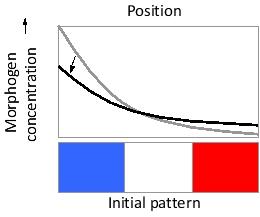Imagine a morphogen gradient established from left to right in a field of cells in a developing tissue, as shown in the following schematic diagram. Below a first threshold of morphogen concentration, cells do not respond to the morphogen and express gene "red" by default. Cells exposed to morphogen concentrations above this threshold respond by expressing gene "white" instead, while those exposed to even higher concentrations, above a second threshold, express gene "blue." As shown, the initial pattern resembles a French flag with equally wide blue, white, and red expression domains. With no other change, if the diffusion rate of the morphogen is increased (by a modification that decreases its affinity for heparan sulfate proteoglycans, for example), the gradient profile changes from the gray curve to the black curve, as indicated. Under this new condition, indicate whether each of the following would be expected to increase (I), decrease (D), or remain unchanged (U) in its range. Your answer would be a three-letter string composed of letters I, D, and U only, e.g. UUI.

( ) Blue expression domain
( ) White expression domain
( ) Red expression domain
Definitions:
Theory of Mind
The ability to attribute mental states—beliefs, intents, desires, emotions, knowledge—to oneself and others and to understand that others have beliefs and desires different from one's own.
Centration
A term from cognitive development theory describing a focus on one aspect of a situation while ignoring others, common in early childhood.
Vocabulary Explosion
Vocabulary explosion refers to the rapid increase in the number of words a child learns and uses, typically occurring between the ages of two and three.
Lateralization
The tendency for some neural functions or cognitive processes to be specialized to one side of the brain or the other.
Q3: Calcitonin,a hormone secreted by the thyroid gland,helps
Q11: Which one better supports cell proliferation when
Q22: In which of the following groups of
Q25: Indicate whether each of the following descriptions
Q29: Indicate whether each of the following normally
Q31: Blood platelets in an adult human …<br>A)
Q35: What two cell-surface receptors are represented in
Q37: Indicate true (T) and false (F) statements
Q51: Which provides the most fiber?<br>A) 3 oz
Q53: In the following schematic diagram depicting the